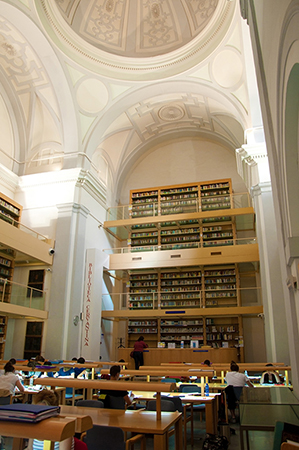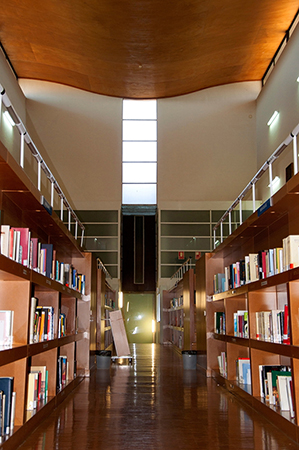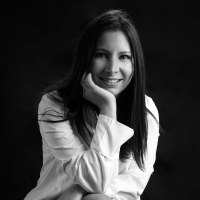Gropius wrote a book on grain silos,
Le Corbusier one on aeroplanes,
And Charlotte Periand brought a new
object to the office every morning,
But today we collect ads. (1)
My collection is rather modest, as well as its aim. I collect libraries photographs. This collection has been circumstantial; I didn’t pretend to form any criteria or theory from it. It just implied the simple fetishism of documenting them, simultaneously with the process of investigation of my doctoral thesis, whose routine moved me, each opportunity, in a random act, to visit a new library. This activity could be described as a psichogeography, a species of dérive that pretends to understand the effects of the routes and the forms of the city in the emotions and the behaviour of the people in the construction of their identities.

Architecture School Library UAH
Photo: Yisel Gómez Campos
The Smithson’s collection was plenty of information of a life style that was invented and documented simultaneously. The Le Corbusier’s one neither was a simple footer in the genesis of his theories, encompassed in the context of the machine era. My collection reveals a personal state, although, inevitably it constructs reflections at other scales.

Cervantina Library UAH
Photo: Yisel Gómez Campos
Psychotectures
“Imagine a hybrid discipline with the name of ‘Psychotecture’”.(2) Imagine that the practice will make a trip through this collection. My first library was, of course, the one of the Architecture School,(3) former church of the “Carmelitas Descalzas” convent. “When entering you think that you are in a temple, but in the immediate second you noticed you are in a library… Sensory we tried to recover the XVII century space through the use of baroque light”.(4) The line between the perception of religious temple and space for studying is quite thin. It’s a temple at last: stealth, introspection and the tough contrast of the chiaroscuros, empowers an atmosphere and a perspective of theatricality, characteristic of the baroque. “We pretend with every intervention, that despite the functioning of the new use, the religious character of the space won’t lose”.(5)

Cervantina Library UAH
Photos: Yisel Gómez Campos
Somebody will affirm that “the folly is normal in the Library and that the reasonable (…) is almost a miraculous exception”.(6) Any ambitious attempt of knowing all the secrets of “the Library” (the Universe) unties the internal demons. Or perhaps the chiaroscuro has enhanced the effects of the mind and has provoked a kind of vertigo.

Documentation Faculty Library UAH
Photo: Yisel Gómez Campos
Vertigo, as the one caused by the glass stairs and corridors of the “Cervantina”(7) Library, former church of the “Trinitarios Descalzos” convent. “Here you have a new perspective that hadn’t being perceived of the religious spaces; you see the temple as you were the images that formerly were placed in the heights”.(8) The effect is fascinating and disturbing, as in the “loops” of Escher, where the single presence of levels invites to the beholder to contemplate him/ herself as part of another level, being trapped by an implicit chain of levels: there will always exist one of major “reality", and also another one "more imaginary".(9) The visual transpositions insinuate the infinite library of Borges: illuminated, solitary, incorruptible, secret, and armed of precious volumes. A “borgescherian re-creation”.(10)
The stairs of the Documentation Library,(11) built in the decade of 1980, also suggest this re-creation to me. Its aaltian ceiling, the prolonged ship and the spectre at the end drawn by the natural light, raises an ambiguity: is this a temple?

Cervantina Library UAH
Photos: Yisel Gómez Campos
Other demons
And these are only three libraries of a collection formed of psychogeographies, psychotectures, and other demons that in this case appear inevitably at the light of social psychology. The transformation and refunctionalization of these buildings reveal the secularization process that certain societies are facing. Sciences, arts and other human expressions, that were before hardly influenced by religious groups, nowadays they reveal their role at the margin of them.
“… the vast contradictory Library, whose vertical deserts of books… affirm everything, deny and confused it as a delirious divinity”.(12)
---
(1) SMITHSON, Alison; SMITHSON, Peter. “But today we collect adds”. In: Architecture d’aujourd’ hui. January-february 2003. Pgs. 40-45.
(2) CHANG, Chris. “Broken Home. Gordon Matta-Clark’s appetite for reconstruction”. Film comment magazine. Issue.4, July-august 2007. Pg. 17
(3) University of Alcala, UAH. Santa Ursula St. Alcalá de Henares. Madrid.
(4) DE LA QUINTANA, José Luis. Interview by Verónica Rosero to the architect in charge of the projects related to the Libraries of Architecture, Philology, Cervantina, between others. Alcalá de Henares. May 26th, 2011.
(5) Op.cit(4)
(6) BORGES, Jorge Luis. “La Biblioteca de Babel”. Universidad de la Laguna. La Laguna. 2000.
(7) University of Alcala. Trinidad St. Alcalá de Henares, Madrid.
(8) Op. cit.(4)
(9) HOFSTADTER, Douglas. "Gödel, Escher, Bach. Un eterno y gracil bucle". Ed. Tusquets. Barcelona. 2009. Pg. 17
(10) MANZOR Coats, Lillian. “Borges/Escher, Sarduy/CoBrA: Un encuentro posmoderno. Ed. Pliegos. Madrid. 1996. Pg. 67
(11) University of Alcala. San Cirilo St. Alcalá de Henares, Madrid.
(12) BORGES, Jorge Luis. “La Biblioteca Total”. Revista Edición Escrita. Nº 5. Córdoba, Argentina. 1983.
TO BE CONTINUED... NEXT WEEK MORE!! > "THE OTHER FACE OF CONSTRUCTION"
IN TREATMENT - METALOCUS.
DIRECTOR: JOSÉ JUAN BARBA. COORDINATION: INÉS LALUETA. ORGANIZATION: INÉS LALUETA, PEDRO NAVARRO. ENGLISH VERSION: KAREN SIMPSON. GUESTS FIRST SEASON: JOSÉ JUAN BARBA, MARINA DIEZ-CASCÓN, SERGIO DIEZ-CASCÓN SOLER, LARA FERNÁNDEZ GONZÁLEZ, CARLOS GERHARD PI-SUÑER, MONTSE PLA GARCÍA-CASTANY, XAVIER NICOLAU CUYÀS, FERNANDO RIAL PONCE, VERÓNICA ROSERO.






















